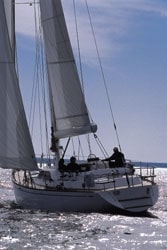
C01BOTY14.jpg
Of the 29 boats we tested, seven were designed with a cabin house thats raised to bring light into the main saloon and provide virtually 360-degree visibility from below. Well discuss three later, in the category of luxury cruisers. Of the other four, the Tayana/Vancouver 460 Pilot is the only pilothouse in the traditional sense of having mechanical steering from the cabin. The Farr 50 Pilot House, designed by Bruce Farr and built in Sweden to specs from Boat Sales International in England, has an autopilot joystick at the nav station below; otherwise, its more akin to the boats called “deck saloons.” The North Wind 50 is an ICW-friendly center-cockpit sloop built by a Barcelona yard thats been around since 1973. Finally, the Sparkman & Stephens-designed Stellar 52 Center Cockpit was built in Taiwan to specs from Stellar Offshore Yachts in Washington state.
Of these, the judges deemed the Stellar 52 the best combination of construction, layout, and value.
“Structurally,” said Ralph, “I think it was well done. It was basically Sparkman & Stephens adhering to an American Bureau of Shipping type of standard. The hull/deck joint is fastened on six-inch centers, sealed, and glassed. There are stringers inside the hull for stiffness.”
The Stellars simple cruising rig drew praise from the sailmaker. “Call me old-fashioned,” said Carol, “but I liked the rig. With more sophisticated rigs, youve got to go aloft to start tweaking on diagonals and reverse diagonals. With this rig, you could really stay on top of it, and do it from the deck.”
She also liked the Stellars deck layout. “The staysail track was in the right place on the cabin house. You could actually go to weather with that in a real blow because it has an inboard sheet lead. And it worked well with the genoa if you wanted to fly the two of them together.” On the Farr and the North Wind, the genoa and staysail share the same sheeting base.
Alvah liked that there was room on deck for a dinghy. “It wasnt just the size of the boat; the foredeck layout left room for a good-size hard dinghy or RIB.”
He also found the cockpit designed well for keeping water out: “It had a nice rise on the bridgedeck from the cockpit, four one-and-one-quarter-inch scuppers, and a very stout, small main hatch, which I like.”
None of the judges was fond of the extent to which the deck-saloon design raises a boats center of gravity. “According to the numbers from S&S;, the area of negative stability begins at 115 degrees,” said Ralph, “and thats with the understanding that the ballast is where its supposed to be. That 115 is the minimum number youre allowed to have in the summertime Newport-to-Bermuda race. If you have 114, youre not in the race.” In terms of ballast/displacement ratio, the Stellar (.315) fell in the middle of its group, ahead of the Tayana/Vancouver (.238) and North Wind (.272) but behind the Farr (.353), whose ballast is concentrated at the base of the keel.
The interior, finished with South American cherry on the vertical surfaces and a light pear on the horizontals, is lovely. “You have a lot of handrails and handholds down below,” said Carol.
She also liked the big chart table at the nav station, “one where you could actually get out parallel rules and dividers” in an age when many boatbuilders think well be doing all our navigating electronically.
On the topic of electrics, Skip ranked the Stellars with the Morris (Luxury Cruiser category): “The electrical panel wasnt only engineered beautifully; it was logical as hell. The design grouped together the pumps and the lights, and all the wiring was led to the back of the boards. That panel was just gorgeous.” As for engine access, Skip found it “a little difficult to get to some of the gear along the outer sides of the box,” but he noted that the engine would come out easily if you had to remove it.
Alvah saw individual things he would change, such as a complicated self-launching anchor roller whose entire structure depended on a single bolt. But when the judges compared the whole boat on its own merits with the Tayana/Vancouver and the North Wind, and given the $145,000 difference in price with the Farr 50, they felt unanimously that the Stellar rose to the top.








